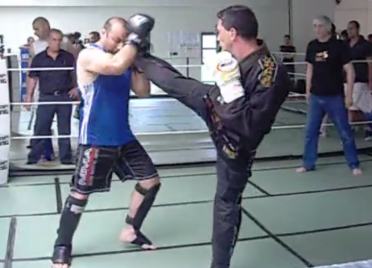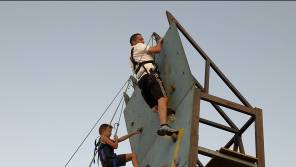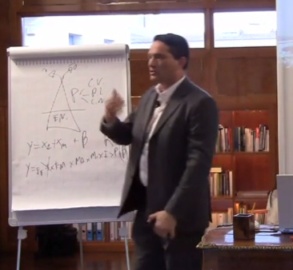Spirito di rinuncia o Sparta? Il coraggio di essere, di vivere, di diventare
di Daniele Trevisani, Formatore, Consulente in Formazione Strategica www.studiotrevisani.it – Estratto dal volume “Il Coraggio delle Emozioni” Franco Angeli Editore.
A qualsiasi età, è bene sentirsi un guerriero che si sta allenando.
Nelle aziende, le energie delle persone sembrano a volte spente, come se non ci volesse più la domanda “cosa hai fatto oggi di buono, di positivo, di importante?“, ma bastasse “tirare avanti”. No,non è così. Non farlo nemmeno per, fallo per i tuoi figli e le generazioni future. Ricorda, sei il frutto di gente che ha combattutto e tanto, per farti arrivare qui. Centinaia di generazioni sono servite, perchè tu sia qui, ora, adesso.
Anche in azienda, occorre lottare per costruire un futuro dove i nostri figli non debbano essere costretti ad emigrare. O no? E questo ha molto a che fare con come gestisci il Marketing, le Vendite Internazionali, le Negoziazioni, le Risorse Umane, e soprattutto, la Formazione.
La Formazione è allenarsi ad essere, allenarsi a diventare. Ma diventare cosa? Un profeta, un bravo pizzaiolo, muratore, artista. Sia quello che sia. Va Bene. Un ottimo esperto di Marketing, di Qualità, di Logistica, di Recruiting, va benissimo. Puoi esplorare tutte le potenzialità che potresti esprimere nella vita, sino all’ultimo respiro. Puoi cambiare vita ed essere molte cose, cambiare pelle, girare tra vari strati sociali, e culture.
È sufficiente che non ti accontenti di vivere una vita spenta.
Nessuna vita deve essere sprecata. E nei momenti in cui senti che lo sia, proprio in quei momenti, può e deve nascere la voglia di fare qualcosa per cambiare.
Per farlo, serve coraggio.
Il coraggio è una caratteristica umana tra le più difficili da coltivare.
Molti pensatori vi si sono avvicinati e il loro pensiero è per noi stimolo importante.
Tiziano Terzani sostiene che: “Il coraggio è il superamento della paura”[1]. Questo coraggio si trova nelle scelte difficili, nei bivi esistenziali, nei momenti in cui si trova una strada incerta, per cui:
La regola secondo me è: quando sei a un bivio e trovi una strada che va in su e una che va in giù, piglia quella che va in su.
È più facile andare in discesa, ma alla fine ti trovi in un buco.
A salire c’è più speranza. È difficile, è un altro modo di vedere le cose, è una sfida, ti tiene all’erta.[2]
Anche secondo Ralph Waldo Emerson, tra i primi pensatori americani più influenti sul movimento per potenziale individuale, il coraggio consiste nel superamento delle paure. E questo non in termini di scelte eroiche, ma di atteggiamento quotidiano.
Il suggerimento preciso di Emerson per imparare la lezione della vita è quello di “vincere una paura ogni giorno”.
Non ha imparato la lezione della vita
chi non vince una paura ogni giorno
(Ralph Waldo Emerson)
Il coraggio quindi smette di essere un atteggiamento solo epico o eroico, qualcosa da fare “ogni tanto”, e “se si presenta l’occasione della vita”, ma diventa un atteggiamento quotidiano, ogni singolo giorno un piccolo piccolo passo.
Esercitarlo un pò ogni giorno lo allena, lo potenzia. Ad esempio, andare sul ring ogni giorno, fa passare la paura del ring. Iniziare a guidare, e fare ogni giorno un pò di strada, allena alla guida. E prendere una strada nuova, allena ancora di più.
Anche secondo Osho, se se non vi fossero paure non vi sarebbe nemmeno la possibilità di definire il coraggio.
E questo significa fare le cose nonostante si abbia paura, e non perché non si ha paura[3].
La parola “coraggio” è molto interessante: viene dalla radice latina cor, che significa “cuore”;
quindi essere coraggiosi significa vivere con il cuore….
…la via del cuore è la via del coraggio: essa significa vivere nell’insicurezza, nell’amore, nella fiducia e ti orienta verso l’ignoto.
È la via che ti fa abbandonare il passato e ti apre al futuro.
Essere coraggiosi significa incamminarsi su percorsi pericolosi. La vita è pericolosa, solo i codardi evitano i pericoli e, così facendo, sono già morti.
(Osho)
La sfida del potenziale umano consiste nello scoprire come fare i conti con la paura. Non si tratta di un atteggiamento autodistruttivo o di gettarsi nel fuoco tanto per provare. Nemmeno di provare a farsi male quando questo sia certo.
Si tratta di sconfiggere le sensazioni di paura immotivate che sono radicate in noi e quelle che ci limitano solamente ma non hanno radici nella realtà se non in noi.
La persona forte è proprio quella che va avanti e nel frattempo ha paura, ma persevera. Vado avanti nonostante la paura: questo è atteggiamento eroico.
A volte si tratta persino del vincere la paura di riposare in un ambiente dove tutti corrono come formiche. Sia quello che sia.
Quando un certo atteggiamento combattivo si consolida, diventa schema mentale e comportamentale. La “percezione delle cose”, come nel giovane combattente del film “300”, è diversa in chi guarda gli eventi e il futuro con spirito di lotta rispetto a chi guarda il mondo con spirito di rinuncia.
Non è la paura a governarlo, ma solo una cresciuta percezione delle cose: l’aria fredda nei polmoni,
i pini piegati dal vento della notte che incombe.
Le sue mani sono ferme. La sua forma: perfetta.
(Dal film: “300” di Zack Snyder)
L’abitudine all’ambiente negativo accettato senza lottare porta a uno stato di apatia, mancanza di uno stimolo di reazione adeguato. Si finisce per non sentire più il veleno che circola, l’aria viziata o velenosa.
Si finisce per non lottare.
Al contrario, le frasi dal film “300” evidenziano bene lo spirito combattivo che vigeva a Sparta.
Qui è dove li bloccheremo…
Qui è dove combatteremo…
Qui è dove moriranno!
Questo spirito viene inculcato e assorbito durante la crescita:
gli insegnarono a non indietreggiare mai a non arrendersi mai,
gli insegnarono che la morte sul campo di battaglia al servizio di Sparta era la gloria più grande che la vita avrebbe potuto offrirgli.
Il concetto di onore si associa a quello della lotta per una causa.
Soldato Spartano: Mio re! È un onore morire al tuo fianco…
Re Leonida: è un onore aver vissuto al tuo…
Un’ulteriore caratteristica del clima combattivo è un clima psicologico permeato di forza e coraggio, la presenza di un atteggiamento, esteso e permeante di non-rassegnazione. Uno spirito che a Sparta tocca tutti:
(messaggero) Le vostre donne saranno fatte schiave…
(Leonida, Re di Sparta) Evidentemente non conosci le nostre donne… avrei potuto mandare anche loro a combattere.
Ogni persona vive in un certo clima psicologico circostante e ne assorbe dei tratti, venendone potenziato o depotenziato. Il suo scatto di orgoglio sa nell’andare oltre questo clima, soprattutto quando questo è depotenziante.
La realtà psicologica non è sempre simile a quella di Sparta, non sempre, non per tutti, non ovunque. Ma la dobbiamo cercare.
Ultimo, ma assolutamente non meno importante, il coraggio – il coraggio morale, il coraggio delle proprie convinzioni, il coraggio di vedere attraverso le cose. Il mondo è in costante cospirazione contro i coraggiosi. È una battaglia vecchia come il tempo – il ruggito della folla da un lato e la voce della tua coscienza dall’altro.
(Douglas Macarthur)
La gioia di vivere deriva dall’incontro con nuove esperienze, e quindi non esiste gioia più grande dell’avere un orizzonte in costante cambiamento, del trovarsi ogni giorno sotto un sole nuovo e diverso… Non dobbiamo che trovare il coraggio di rivoltarci contro lo stile di vita abituale e buttarci in un’esistenza non convenzionale…
(Dal film Into the wild)
[1] Fonte: http://it.wikiquote.org/wiki/Tiziano_Terzani
[2] Ibidem.
[3] Osho (Bhagwan Shree Rajneesh) (2003), Il coraggio. Come vivere la propria esistenza senza mai tirarsi indietro. Riza Edizioni, Milano.
_____
di Daniele Trevisani, Formatore, Consulente in Formazione Strategica www.studiotrevisani.it – Estratto dal volume “Il Coraggio delle Emozioni” Franco Angeli Editore.




